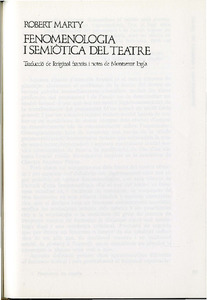Fenomenologia i semiòtica del teatre
Metadata
Show full item record
Estudis escènics: quaderns de l'Institut del Teatre. 1983, Núm. 23
Document typeArticle
Abstract
<p>This article attempts to show that Ch. S. Peirce's phenomenology and semiotics can help in approaching in scientific terms the theory of drama (and more generally speaking of entertainment), thus providing an answer to Antonin Artaud, who called for the elaboration of a coded language, comparable to a musical transcription.</p>
<p>A brief summary of the peircean phenomenology enables us to model the articulation of production and interpretation around performance, and shows the essentialles triadic character of the phenomenology of drama.</p>
<p>Semiotics, used here in as much as it relates to drama. is a means of formalizing, for instance, the triads of the interpretation into different signs (in this case, legisign). We can then describe each of them using a numerical system of notation and a new combinatorial expressed in terms of a non linear order structure (a lattice). We then briefly introduce a modelling of the processes by which meaning is established, using the concept of semiosis, as a convergent sequence of successive interpretations. Finally, a formal structure of algebraic totalization can aggregate (synchronically) the constituent signs of dramatic complexity, at any given time, into a global meaning sign; it also enables us to describe the diachronic transformation of the same meaning with the gradual elaboration of new signs on the stage.</p>
<p>As a conclusion, it might seem that the formal structure presented is still too powerful to do justice to the full complexity of drama however, it is possible to improve it and it may be able to reach the highest degree of sophistication with the help of the people involved.</p>
Access conditionsOpen Access
ISSN2385-362X
,
0212-3819
Collections
- 1983: Núm.: 23 [7]


